Tirumalai (Tamil Nadu)
Tirumalai (lit. "the holy mountain"; also later Arhasugiri, lit. "the excellent mountain of the Arha[t]"; Tamil Engunavirai-Tirumalai, lit. "the holy mountain of the Arhar" is a Jain temple and cave complex dating from at least the 9th century CE that is located northwest of Polur in Tamil Nadu, southeast India.[1] The complex includes 3 Jain caves, 2 Jain temples and a 16.25-foot-high (4.95 m) sculpture of Tirthankara Neminatha thought to date from the 12th century CE that is the tallest Jain image in Tamil Nadu.[2][3] Arahanthgiri Jain Math is also present near Tirumalai complex.[1]
| Tirumalai | |
|---|---|
| |
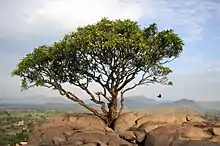 Peak of Tirumalai | |
| Religion | |
| Affiliation | Jainism |
| Deity | Neminath |
| Festivals | Mahavir Janma Kalyanak |
| Location | |
| Location | Tiruvannaamalai, Tiruvannamalai district, Tamil Nadu |
| Geographic coordinates | 12.556675°N 79.205946°E |
| Architecture | |
| Date established | 9th century CE |
| Temple(s) | 2 |
History
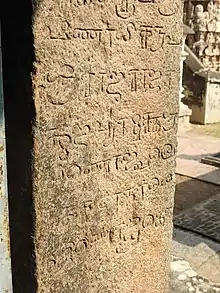
Tirumalai has been an important Jain center since ancient times. It is believed that 8,000 Jain monks who accompanied Bhadrabahu did the penance and attained nirvana here. The footprints of four great saints - Vrishabhsenachrya, Samanatabhadracharya, Varadattachrya munivar and Sri Vadeepa Simhasuri are also present here.[4] An inscription dating back to 1024 CE is present mentioning the name Kunthavai Jinalaya temple.[5] This inscription mentions the list conquest done by Rajendra Chola I and the offerings made by him to Kunthavai Jinalaya temple.[6]
Early site
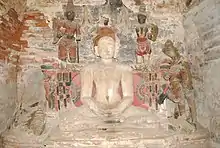
The large cavern at the base of the site is thought to have been built around the 9th century. In the 10th century it was converted into 30 separate chambers, possibly to accommodate figures of Tirthankaras and a yakshi. Similar to Ellora caves, the representation of celestial being performs a ritual on tirthankara is present.[7]
An inscription found on a buried rock in front of the gopura at the base of the hill from the late 10th century refers to the site as Vaigai-malai or “the mountain of Vaigai.” Two other inscriptions found on a piece of rock at the top of the hill and buried on a piece of rock underneath the steps between the gopura and the painted cave refer to it as Vaigai-Tirumalai or “the holy mountain of Vaigai.” The name Vaigai is thus thought to be connected with Vaigavur, the historic name of the village at the base of the rock.[6]
Jain temples

Kuntahavai Jain temple
The Kunthavai Jinalaya temple is a 10th-century Jain temple, said to have been commissioned by the Princess Kundavai of the Chola Dynasty. It is one of two such sites commissioned by her, though the other site, Dadapuram, has not survived.[8][9]
This temple is situated on top of the Tirumulai hill with engraving of Mahavira flanked by two lions. This temple is partly excavated and partly built within caverons of the rock. This temple is rich in sculptures and base-relief. This temple contains the 16.25 feet (4.95 m) monolithic sculpture of Neminatha.[10] This idol is tallest Jain idol in Tamil Nadu.[3] There are footprints of Jain monks to commemorate their nirvana near the temple.[11]
Mahavir temple
In the 16th century, a second temple for Mahavir was built to the west of the Kunthavai Jinalaya.[12][3]
Parshvanath temple
In the 17th century, a third temple for Parshvanath was constructed.[3]
Paintings
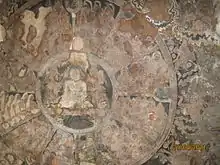
Paintings are thought to have been added to the site between the 15th-17th centuries. Some of these still survive. These painting are considered comparable to that of present in Ellora caves.[13]
The painting of Parshvanatha with hood of five snakes[14] venerated by monks, nuns and others is the one of the most notable painting in Tirumali complex.[2] Kuntahavai Jain Temple features a painting with depiction of Samavasarana similar to that of present in Shravanabelagola.[15] The paintings of Ambika, Parshvanatha and Bahubali are also noteworthy.[12]
Jain Matha
Arahanthgiri Jain Math is a Jain Matha that was established near the site in August, 1998.[1][16]
Conservation
These caves are protected by Archaeological Survey of India.[17]
Gallery
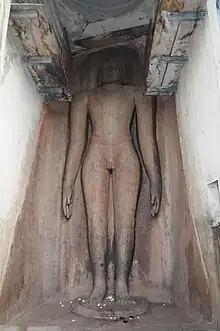
 Detailed carvings at Tirumalai
Detailed carvings at Tirumalai Shikhara with detailed carving, Kuntahavai Jain Temple
Shikhara with detailed carving, Kuntahavai Jain Temple
 Paintings on ceiling
Paintings on ceiling Cave structure
Cave structure
See also
References
Sources
- Mani 2018, p. 181.
- Sewell 1882, p. 170.
- Pal 2014, p. 134.
- Umamaheshwari 2018, p. 138.
- Veluppillai 2003, p. 330.
- Umamaheshwari 2018, p. 142.
- Owen 2012, p. 21.
- Singh, Pant & Prasad 2000, p. 107.
- Singh, Nagendra Kumar (2001). Encyclopedia of Jainism. Anmol Publications Pvt. Ltd. p. 1000.
- Cox 1881, p. 215.
- Titze & Bruhn 1998, p. 75.
- Shah 1987, p. 169.
- Owen 2012, p. 20.
- Shah 1987, p. 186.
- Shah 1987, p. 25.
- "Arihantagiri - Tirumalai". Archived from the original on 7 November 2012. Retrieved 10 April 2012.
- ASI & Vellore sub-circle.
Citation
- Titze, Kurt; Bruhn, Klaus (1998), Jainism: A Pictorial Guide to the Religion of Non-Violence (2 ed.), Motilal Banarsidass, ISBN 978-81-208-1534-6
- Mani, Ajit (2018), The Nawab's Tears, Partridge Publishing, ISBN 9781543704280
- Veluppillai, Alvappillai (2003), "Jainism in Tamil Inscriptions", in Qvarnström, Olle (ed.), Jainism and Early Buddhism: Essays in Honor of Padmanabh S. Jaini, Jain Publishing Company, pp. 315–332, ISBN 9780895819567
- Owen, Lisa (2012), Carving Devotion in the Jain Caves at Ellora, Brill's Indological Library, vol. 41, Brill Publishers, ISBN 9789004206298
- Singh, Purshottam; Pant, P. C.; Prasad, Maheswari (2000), Bhāratī: Bulletin of the College of Indology, vol. 23, Banaras Hindu University
- Umamaheshwari, R. (2018), Reading History with the Tamil Jainas: A Study on Identity, Memory and Marginalisation, Sophia Studies in Cross-cultural Philosophy of Traditions and Cultures, vol. 2, Springer, ISBN 9788132237563
- Sewell, Robert (1882). New Imperial Series. Vol. 7. Archaeological Survey of India.
- Cox, Arthur Frederick (1881), A Manual of the North Arcot District in the Presidency of Madras, E. Keys
- Pal, Susant (2014), Imbibed in Faith, Partridge Publishing, ISBN 9781482812596
- Shah, Umakant Premanand (1987), Jaina-rūpa-maṇḍana, vol. 1, Abhinav Publications, ISBN 9788170172086
- "Vellore sub-circle". Archaeological Survey of India.